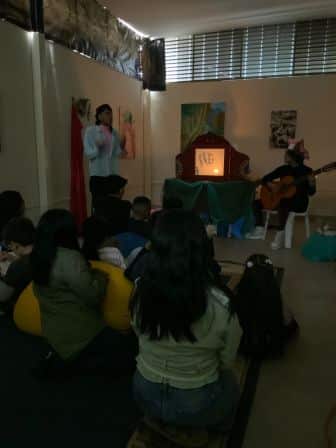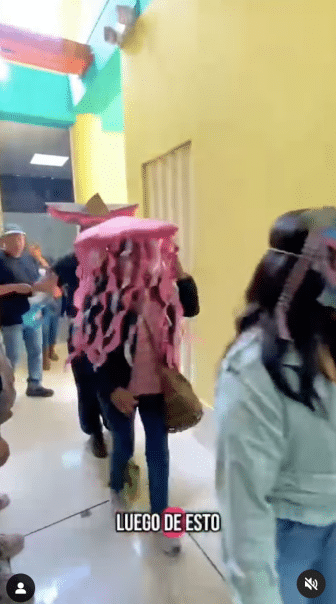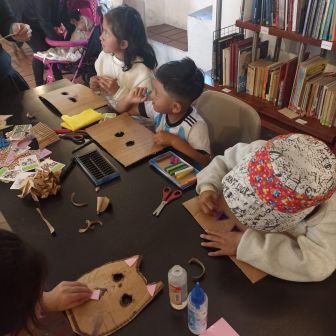Sol Miranda from the Hermafrodita Puppet Collective, Quito, Ecuador

Our puppetry collective Hermafrodita is based in the south of Quito, Ecuador’s capital city, and thanks to DEY’s mini-grant, we were able to provide a full arts program for kids in three underprivileged child care centers across the city. Our program’s primary objective was to validate and nurture children’s freedom of self-expression, creativity, and identity by widening the scope of gender roles through the arts. We did this in the following way: Mask-making workshop: Ecuador has a deep-rooted mask tradition, often worn in local, mostly-indigenous festivities that mark and celebrate equinoxes and solstices. This is why it’s important to recognize this mask making workshop as something that sustains a cultural tradition and identity in an uphill battle against the westernizing forces of modernity.
The workshop’s main aim, however, was to invite kids to use their imagination and craft abilities freely by making masks with easily-available and affordable materials: cardboard and egg boxes! Once finished, the kids found out the mask provided them with a new toy and they could turn into superheroes, cartoon characters, animals, sea creatures, or just weird freaky monsters.
This is a tremendous thing because: 1) they made it themselves, it wasn’t fabricated by some large toy company, so the mask really becomes a reflection of some kind of alter ego, alter self. 2) The mask allowed them to have a moment to forget who they are, to not be seen at face-value, in order to get more lost in play without the burden of shame or self-awareness. This last point is important because we saw that the more underprivileged children were, the more prone they were to show signs of 1) shyness and self-awareness and 2) tougher masculine exteriors.

Shadow puppet play: Once kids were done with their masks, they were invited to watch our shadow puppet play based on Jessica Love’s illustrated book “Julian is a Mermaid.” Through storytelling, shadow puppets, and live music kids learned about the story of a little boy who wants to be a mermaid and who is able to make his dream come true thanks to the love and support of his grandmother. The story validates the joy of play and fantasy in dressing up to one’s own imagination, the importance of family love and support, and how personal identity thrives in community. Furthermore, the story offers an alternative image about masculinity that carves out a new space of possibility in children’s imagination. This, we recognize, is quite precious at a time when Ecuador is facing an “inner armed conflict” and young boys and teenagers, particularly those living at the margins, are peppered with imagery of tough, aggressive, and violent hyper-masculinities. One audience member, who is an aunt to a queer child, thanked us personally in tears because she said the story offers hope and love to parents who might be on edge about the expression of sexual and gender differences in their kids. This showed us that we weren’t only having an impact on kids, but also on their parents, family members, and teachers.
Lastly, we want to emphasize how amazing it has been to bring theatre to children and families who had either never been, or only rarely. We love theatre obviously, and we strongly believe it can be a beacon of light and lightness in times of cybernetic addiction and global turmoil.
Dance Parade: The last part involved inviting kids to put on their masks, dress up as little mermaids and sea creatures, for a

final dance parade! Parades have a strong cultural tradition in Ecuador because of the festive traditions that involve wearing masks. So it gave us an opportunity to once again, sustain this tradition, albeit in a different context and setting. Mostly, the idea was to offer kids a chance to bring their mask characters to life, to become mermaids if they wanted, and to move to the music of traditional San Juanitos (a genre of andean music often played during festive occasions in Ecuador). Kids were shy at first, but once the music got going, and we were all in motion, they would enthusiastically play along. An important part here was that we took the parade outdoors, so there was a public visibility part that pushed kids to show themselves all dressed up to strangers. This is huge when we think about kids who are shy, who are afraid of expressing themselves and to be publicly seen. This brings home the importance of mask play for kids, since it offers a protective shell that enables them to feel more free to play and be themselves.
The project took place from January 18 til January 30 of 2025 in three different locations. The first was at the art collective Inti Atelier, a small community space located in Pifo, at the western outskirts of Quito. The second space was the municipal library of Chillogallo, located in the far south of Quito. The third space was a municipal child care center for children whose parents are street vendors, located in the center of town. All these three locations were chosen because they work with families with low income and a socially vulnerable status and because they are in impoverished geographic spaces across the city where art usually doesn’t reach. We had prior contact with all three coordinators and they wholeheartedly welcomed our activities in their spaces.
January. 18: workshop + show + dance parade in Pifo, Quito
January 25: workshop + show + dance parade in Chillogallo, Quito
January 30: workshop + show + dance parade in City Centre, Quito
The project’s funding went to cover: 1: transportation to and from the community spaces 2. all materials for the craft workshop (cardboard, scissors, glue, elastics, crayons, etc.) 3. healthy snacks for the kids 5. meals for three artists 6. honorary stipend for three artists
As previously mentioned in our proposal, Ecuador’s Council of Gender Equity has pointed out that anti-LGBTQIA+

discrimination in the field of education is widespread and that in order to counteract this, early childhood educators should promote classroom spaces where kids can freely choose the toys and clothes they want to play with without judgment or prohibitions. This is nonetheless rarely practiced anywhere, including in countries as progressive as Norway where a 2017 study at twenty different kindergartens showed that staff generally contribute to upholding traditional gender stereotypes, they treat girls and boys differently, and while girls and boys generally challenge prevailing gender structures, kindergarten staff simultaneously conform them to gender stereotypes. If this is true in a country like Norway, generally considered progressive when it comes to gender equity, we can assume this is true in Ecuador, a country where women and LGBTQIA+ people are up against tremendous injustice and discrimination across all socio-economic fields. So offering an alternative way to promote gender self expression and freedom of identity through play and art will be a tremendous step towards changing this dynamic for kids, families, and teachers alike.
The impact can be evaluated as follows: Alternative Masculinities: the story of Julian is a Mermaid offered a new story and imagery for boys who have been generally socialized in more traditional, normative structures of masculinity. It’s hard to measure the impact this might have on the kids, but we trust in the power of art in having planted a loving seed for something else to grow that can be more gentle and accepting towards all kinds of gender expression. We believe that these kinds of alternative images are more urgent and vital for kids and families in a time of heightened armed conflict and militarization in Ecuador. Free self-expression and play: the mask-making workshop offered kids the possibility to use their imagination and craft skills to make their own masks. Once finished they could turn into whoever they wanted to be, without the constrictions of selfhood that can often bring shyness and self-repression. Theater for everyone: we brought theatre to kids and families who had never been to a theatre, or rarely ever. This made theatre more accessible, rather than a leisure activity exclusive to those with money. Furthermore, with the parade kids in a way performed in their own little play, so they got a little taste of how much fun theatre can be. Joy and relief: no matter what was happening at home, kids (and some parents too!) got to have a moment in which their entire focus was on building masks, watching shadow puppets, listening to live music, and getting to play and dance. This validates and sustains the importance of play and presence for children. The hurdles: Not personally involved in organizing children to attend the program: we didn’t get the chance to be part of the logistics in getting kids to join our program. This was always in the hands of local coordinators. However, this didn’t necessarily limit the amount of kids who participated in the program. Boys and teenagers resistance to participate: with older boys, pre-teenage years, it was more difficult to motivate them to add more refined details to their masks (once they thought it was done, it was done), and it was difficult to motivate them to join the parade, let alone dress up as mermaids. Reproduction of violent and hyper-masculine imagery in masks: in some cases (maybe two to four) boys reproduced violent imagery in their masks by adding knives and guns, or painting their masks completely black, with a more frightening aesthetic. We believe this shows a reflection of what’s going on with boys and their masculine identity while also highlighting how much they are exposed and confronted with daily violence. Receiving proper feedback from participants: because the program was long, it was difficult to find a time and moment at the end of the day to sit down with the kids and listen to how their experience went. We would have loved to hear the feedback from them.
One cultural space made a little video clip of our program for social media, you can see it here: https://www.instagram.
